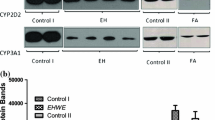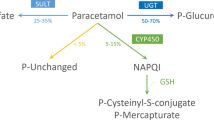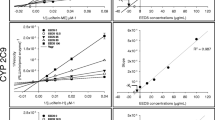Abstract
The purpose of this study was to assess the possible role of the (R)- and (S)- enantiomers of the phenytoin metabolite p-HPPH in the pathogenesis of gingival hyperplasia (GH). About 98% of circulating p-HPPH is in the (S)-form. There were significant differences between patients with and without GH in (R)-p-HPPH level (0.055 vs 0.042 μg·ml−1), both enantiomer/racemate level ratios, and R/S enantiomeric ratio (0.0313 vs 0.0232); an increase in serum (R)-p-HPPH level was observed in patients with GH. In separate experiments, the effect of p-HPPH enantiomers on the proliferation of the normal human dermal fibroblast was studied. The in vitro study showed that (R)-p-HPPH selectively stimulated fibroblast growth. The results suggest that the least abundant metabolite, (R)-p-HPPH, is the most toxic with respect to gingival hyperplasia.
Similar content being viewed by others
References
Butler TC (1957) The metabolic conversion of 5,5-diphenylhydantoin to 5-(p-hydroxyphenyl)-5-phenyl hydantoin. J Pharmacol Exp Ther 119:1–11
Atkinson AJ Jr, MacGee J, Strong J, Garteiz D, Gaffney TE (1970) Identification of 5-metahydroxyphenyl-5-phenylhydantoin as a metabolite of diphenylhydantoin. Biochem Pharmacol 19:2483–2491
Chang T, Savory A, Glazko AJ (1970) A new metabolite of 5,5-diphenylhydantion. Biochem Biophys Res Commun 38:444–449
Ieiri I, Hirata K, Higuchi S, Kojima K, Ikeda M, Yamada H, Aoyama T (1992) Pharmacoepidemiological study on adverse reactions of antiepileptic drugs. Chem Pharm Bull 40:1280–1288
Modeer T, Dahllof G, Karsten J, Otteskog P (1989). Potentiation of fibroblast DNA synthesis by a phenytoin-induced mononuclear cell derived factor in vitro. Scand J Dent Res 97:186–187
Fattore L, Stablein M, Bredfeldt G, Semla T, Moran M, Doherty-Greenberg JM (1991) Gingival hyperplasia: a side effect of nifedipine and diltiazem. Special Care in Dentistry 11:107–109
Barclay S, Thomason JM, Idle JR, Seymour RA (1992) The incidence and severity of nifedipine induced gingival overgrowth. J Clin Periodontol 19:311–314
Eto S, Noda H, Noda A (1992) Chiral separation of barbiturates and hydantoin by reversed-phase high-performance liquid chromatography using a 25 or 50 mm short ODS cartridge column via β-cyclodextrin inclusion complexes. J Chromatogr 579:253–258
Eto S, Noda H, Minemoto M, Noda A, Mizukami Y (1991) Optical separation of racemic 5-(p-hydroxyphenyl)-5-phenylhydantoin by reversed phase high-performance liquid chromatography using eluents containing β-cyclodextrin. Chem Pharm Bull 39:2742–2744
Poupaert JH, Cavalier R, Claesen MH, Dumont PA (1975) Absolute configuration of the major metabolite of 5,5-diphenylhydantoin, 5-(4′-hydroxyphenyl)-5-phenylhydantoin. J Med Chem 18:1268–1271
Butler TC, Dudley KH, Johnson D, Roberts SB (1976) Studies of the metabolism of 5,5-diphenylhydantoin relating principally to the stereospecificity of the hydroxylation reactions in man and in the dog. J Pharmacol Exp Ther 199:82–92
Mackinney AA, Vyas R (1973). The assay of diphenylhydantoin effects on growing human lymphocytes. J Pharmacol Exp Ther 186:37–43
Dill RE, Farmer GR (1991) Phenytoin-induced DNA synthesis and inositol 1,4,5-trisphosphate formation in L-929 fibroblasts. Experientia 47:728–730
Modeer T, Dahllof G, Otteskog P (1982) The effect of the phenytoin metabolite p-HPPH on proliferation of gingival fibroblast in vitro. Acta Odontol Scand 40:353–357
Chapman JR, Roberts DW, Schol HM, Bagwell CB, Hudson JL (1983) Flow cytometric analysis of the effect of phenytoin and its major metabolite on mitogen stimulated mouse spleen cells. Int J Immunopharmacol 5:471–478
Hassell TM, Page RC (1978) The major metabolite of phenytoin (Dilantin) induces gingival overgrowth in cats. J Periodont Res 13:280–282
Smith QT, Hinrichs JE (1987) Phenytoin and 5-(p-hydroxyphenyl)-5-phenylhydantoin do not alter the effects of bacterial and amplified plaque extracts on cultures of fibroblasts from normal and overgrown gingivae. J Dent Res 66:1393–1398
Hassell TM (1981) Phenytoin: gingival overgrowth. In: Myers HM (ed) Epilepsy and the oral manifestations of phenytoin therapy monographs in oral science Vol 9. Karger, Basel, pp 116–202
Modeer T, Dahllof G (1987). Development of phenytoin-induced gingival overgrowth in non-institutionalized epileptic children subjected to different plaque control programs. Acta Odontol Scand 45:81–85
Kantor M, Hassell T (1983) Increased accumulation of sulfated glycosaminoglycans in cultures of human fibroblasts from phenytoin-induced gingival overgrowth. J Dent Res 62:383–387
Dahllof G, Modee T, Otteskig P, Sundqvist KG (1985) Subpopulations of lymphocytes in connective tissue from phenytoin-induced gingival overgrowth. Scand J Dent Res 93:507–512
Hassell T, Stanek III E (1983) Evidence that healthy human gingiva contains functionally heterogeneous fibroblast subpopulations. Arch Oral Biol 28:617–625
Modeer T, Mendez C, Dahllof G, Anduren I, Andersson G (1990) Effect of phenytoin medication on the metabolism of epidermal growth factor receptor in cultured gingival fibroblasts. J Periodont Res 25:120–127
Modeer T, Andersson G (1990) Regulation of epidermal growth factor receptor metabolism in gingival fibroblasts by phenytoin in vitro. J Oral Pathol Med 19:188–191
Conrad G, Jeffay H, Boshes L, Steinberg A (1974) Levels of 5,5,diphenylhydantoin and its major metabolite in human serum, saliva, and hyperplastic gingiva. J Den Res 53:1323–1329
Hassell TM (1982) Evidence for production of an inactive collagenase by fibroblasts from phenytoin-enlarged human gingivae. J Oral Pathol 11:310–317
Brunius G, Modeer T (1989) Effect of phenytoin on intracellular 45 Ca2+ accumulation in gingival fibroblasts in vitro. J Oral Pathol Med 18:485–489
Vogel RI (1980) Relationships of folic acid to phenytoin-induced gingival overgrowth. In: Hassell TM, Johnston MC, Dudley KH(ed) Phenytoin-induced teratology and gingival pathology. Raven Press, New York, pp 163–178
Valle K, Bauer E (1979) Biosynthesis of Collagenase by human skin fibroblasts in monolayer culture. J Biol Chem 254:10115–10122
Mitchell JR, Jollow JR, Gillette JR, Brodie BB (1973) Drug metabolism as a cause of drug toxicity. Drug Metab Dispos 1:418–423
Jollow DJ, Kocsis JJ, Snyder R, Vainio H (1977) Biological reactive intermediates. Plenum Press, New York
Jerina DM, Daly JW (1974) Arene oxides: A new aspect of drug metabolism. Science 185:573–581
Wortel JP, Hefferren JJ, Rao GS (1974) Metabolic activation and covalent binding of phenytoin in the rat gingiva. J Periodontal Res 14:178–181
Fritz S, Lindner W, Roots I, Frey BM, Küpfer A (1987) Stereochemistry of aromatic phenytoin hydroxylation in various drug hydroxylation phenotypes in humans. J Pharmacol Exp Ther 241:615–622
Yasumori T, Chen L, Yamazoe Y, Kato R (1994) Stereoselective hydroxylation of Phenytoin in human liver in relation to mephenytoin hydroxylation polymorphism. Jpn J Clin Pharmacol Ther 25:95–96 (Japanese)
Horai Y, Nakano M, Ishizaki T, Ishikawa K, Zhou H, Zhou B, Liao C, Zhang L (1989) Metoprolol and mephenytoin oxidation polymorphisms in far eastern oriental subjects: Japanese versus mainland Chinese. Clin Pharmacol Ther 46:198–207
Nakamura K, Goto F, Ray WA, McAllister CB, Jacqz E, Wilkinson GR, Branch RA (1985) Interethnic differences in genetic polymorphism of debrisoquin and mephenytoin hydroxylation between Japanese and Caucasian populations. Clin Pharmacol Ther 38:402–408
Küpfer A, Preisig R (1984) Pharmacogenetics of mephenytoin: a new drug hydroxylation polymorphism in man. Eur J Clin Pharmacol 26:753–759
Wedlund PJ, Aslanian WS, McAllister CB, Wilkinson GR, Branch RA (1984) Mephenytoin hydroxylation deficiency in Caucasians: frequency of a new oxidative drug metabolism polymorphism. Clin Pharmacol Ther 36:773–780
Jacqz E, Dulac H, Mathieu H, (1988) Phenotyping polymorphic drug metabolism in the French Caucasian population. Eur J Clin Pharmacol 35:167–171
Author information
Authors and Affiliations
Rights and permissions
About this article
Cite this article
Ieiri, I., Goto, W., Higuchi, S. et al. Effect of 5-(p-hydroxyphenyl)-5-phenylhydantoin (p-HPPH) enantiomers, major metabolites of phenytoin, on the occurrence of chronic-gingival hyperplasia: in vivo and in vitro study. Eur J Clin Pharmacol 49, 51–56 (1995). https://doi.org/10.1007/BF00192358
Received:
Accepted:
Issue Date:
DOI: https://doi.org/10.1007/BF00192358




